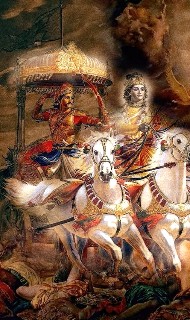 By Isvara Krishna Dasa
By Isvara Krishna Dasa
The Bhagavad-gita is no doubt a major spiritual treatise and one of the world’s greatest classics. Understanding that a hierarchical concept of reality characterizes the Gita can help us see coherence of the Gita’s message. The Bhagavad-gita speaks on two major levels of reality and a third, intermediate, one. We can use the Sanskrit words dharma and moksha to treat the two main levels, and the word yoga for the third. Dharma refers to a set of values representing duty, religion, morality, law, order, and justice, which together sustain civilized human life. Yoga refers to the attempt to detach oneself from worldly life while trying to yoke oneself to the liberated state. Moksha refers to the liberated state of perfection and eternal existence in pure devotional service to the Supreme Lord, Sri Krishna. The level of dharma represents the human or worldly condition, the level of moksha represents the real or absolute condition (liberation), and the level of yoga is intermediate. We can also define these three levels as the finite, the intermediate, and the infinite.
